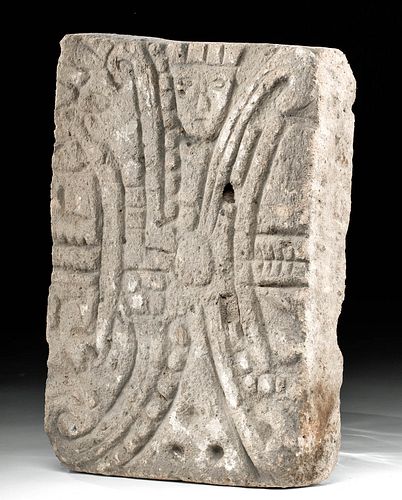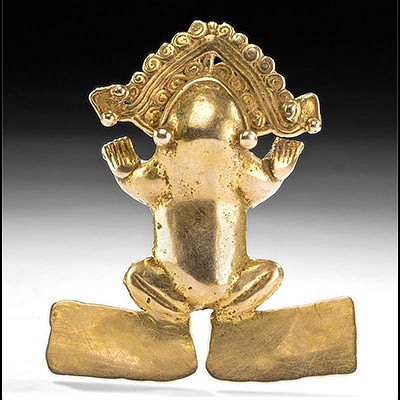Teotihuacan Carved Stone Panel, ex-Stendahl
Lot 97a
About Seller
Artemis Fine Arts
686 S Taylor Ave, Ste 106
Louisville, CO 80027
United States
Selling antiquities, ancient and ethnographic art online since 1993, Artemis Gallery specializes in Classical Antiquities (Egyptian, Greek, Roman, Near Eastern), Asian, Pre-Columbian, African / Tribal / Oceanographic art. Our extensive inventory includes pottery, stone, metal, wood, glass and textil...Read more
Estimate:
$4,000 - $6,000
Absentee vs Live bid
Two ways to bid:
- Leave a max absentee bid and the platform will bid on your behalf up to your maximum bid during the live auction.
- Bid live during the auction and your bids will be submitted real-time to the auctioneer.
Bid Increments
| Price | Bid Increment |
|---|---|
| $0 | $25 |
| $300 | $50 |
| $1,000 | $100 |
| $2,000 | $250 |
| $5,000 | $500 |
| $10,000 | $1,000 |
| $20,000 | $2,500 |
| $50,000 | $5,000 |
| $100,000 | $10,000 |
| $200,000 | $20,000 |
About Auction
By Artemis Fine Arts
Aug 13, 2020
Set Reminder
2020-08-13 10:00:00
2020-08-13 10:00:00
America/New_York
Bidsquare
Bidsquare : Fine Antiquities, Ethnographic & Fine Art
https://www.bidsquare.com/auctions/artemis-gallery/fine-antiquities-ethnographic-fine-art-5415
Features classical antiquities, ancient and ethnographic art from cultures encompassing the globe. Egyptian, Greek, Roman, Etruscan, Near Eastern, Asian, Pre-Columbian, Native American, African / Tribal, Oceanic, Spanish Colonial, Russian, Fine Art, so much more! Artemis Fine Arts info@artemisfinearts.com
Features classical antiquities, ancient and ethnographic art from cultures encompassing the globe. Egyptian, Greek, Roman, Etruscan, Near Eastern, Asian, Pre-Columbian, Native American, African / Tribal, Oceanic, Spanish Colonial, Russian, Fine Art, so much more! Artemis Fine Arts info@artemisfinearts.com
- Lot Description
Pre-Columbian, Valley of Mexico, Teotihuacan, ca. 150 to 650 CE. A large, wonderfully carved volcanic stone panel made by skilled artisans for the monumental architecture of Teotihuacan. The panel features incised imagery including the head of a figure wearing a large headdress offset near its top. Tall, curved lines terminating in scrollwork surround this figure, forming the mouth of a serpent-like creature whose teeth are visible along the upper jaw. A large eye-like feature is also visible on the creature. Remains of white pigment, or possibly plaster backing meant to be painted over, are still visible in several areas on the surface. The other sides are smoothed to allow this panel to be placed into a wall. Size: 2.25" L x 9.25" W x 13" H (5.7 cm x 23.5 cm x 33 cm)
Teotihuacan is the largest pre-Columbian site in the Americas, called the City of the Gods by the Aztecs, who were as fascinated by its ruins and lost culture as we are today. The artisans of Teotihuacan were masters at carving stone. The talud-tablero style of architecture - which first became popular during the Early Classic Period at Teotihuacan but would go on to be used throughout pre-Columbian Mesoamerica - required panels like this one (called the tablero) to sit perpendicular to the ground. The serpent iconography on this example probably relates to the feathered serpent god who dominates so much Teotihuacan imagery (and was the inspiration for the Aztec god Quetzalcoatl).
Provenance: ex-Alfred Stendahl collection, owner of Stendahl Gallery, Los Angeles, California, USA, acquired before 1970
All items legal to buy/sell under U.S. Statute covering cultural patrimony Code 2600, CHAPTER 14, and are guaranteed to be as described or your money back.
A Certificate of Authenticity will accompany all winning bids.
We ship worldwide and handle all shipping in-house for your convenience.
#153790Small losses from edges, notably lower right, and a few small losses from the surface. The stone is weathered but the motifs are generally well preserved and some of the original pigment is still present.Condition
- Shipping Info
-
All shipping is handled in-house for your convenience. Your invoice from Artemis Gallery will include shipping calculation instructions. If in doubt, please inquire BEFORE bidding for estimated shipping costs for individual items.
-
- Buyer's Premium



 EUR
EUR CAD
CAD AUD
AUD GBP
GBP MXN
MXN HKD
HKD CNY
CNY MYR
MYR SEK
SEK SGD
SGD CHF
CHF THB
THB














